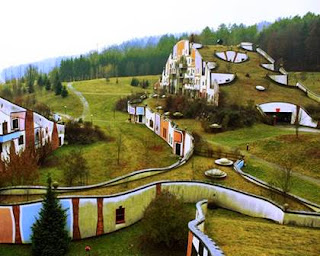I’m only highlighting 4 of the 8 roofs this article talks about. There 4 more great green roofs and a lot more information in the article. --Gene
Look up
The hills are alive with lush greenery — but so are many rooftops. Green or living rooftops, long popular in Europe, are becoming common with both private and business owners alike. The green roof industry grew by as much as 28 percent in 2010. Why? Green rooftops, which are relatively thin layers of greenery affixed to a roof, can act as effective insulators, thus reducing energy costs. They also last longer and can absorb stormwater, acting as valuable drainage systems. Green rooftops can provide a pleasant escape for inhabitants of an urban jungle. This photo features the Mountain Equipment Coop, a popular outdoor equipment store in Toronto. Who knew a meadow could appear on a skyline? (Text: Katherine Butler)
An intensive rooftop is another kind of green roof. This is more of an elevated park that has been cultivated as any regular park might. According to Discovery, intensive green rooftops “can sustain shrubs, trees, walkways and benches with their complex structural support, irrigation, drainage and root protection layers. Chicago’s 20,300-square-foot City Hall contains more than 20,000 herbaceous plants installed as plugs, including 100 woody shrubs, 40 vines and two trees: a Cockspur hawthorn and prairie crabapple.
Sod roof church, Hof, Iceland
Green rooftops seem like a modern innovation but have in fact been around for hundreds of years. Sod roofs are popular in Iceland and Scandinavia, which have a long tradition of using sod on farm houses and buildings. The ancient Hanging Gardens of Babylon may be the first evidence of green rooftops. Around 600 B.C., Babylonian king Nebuchadnezzar II is thought to have created a series of lush garden terraces that ascended to the sky.
Rogner Bad Blumau Hotel, Styria, Austria
The Rogner Bad Blumau Hotel is a wellness spa offering tranquility in the Austrian forest. And because of its green housetops, it blends into the landscape. Such rooftops can alleviate water runoff and sewage overflows. Further, the vegetation on the roof acts as a natural water filter and serves to cool the surrounding air through evapotranspiration, which Discovery describes as “a natural process that cools the air as water evaporates from plant leaves.”
Coombs Country Market, British Columbia, Canada
Keeping up the traditions of the old world in modern times, the Coombs Country Market in British Columbia was built by the Graaten family, Norwegian immigrants who came to Vancouver Island in the 1950s. Using the sod-roof construction popular in his homeland, Kristian Graaten built the sod roof to celebrate his origins.
For the rest of the roofs and more information on each one go to 8 lush green rooftops from around the globe.






